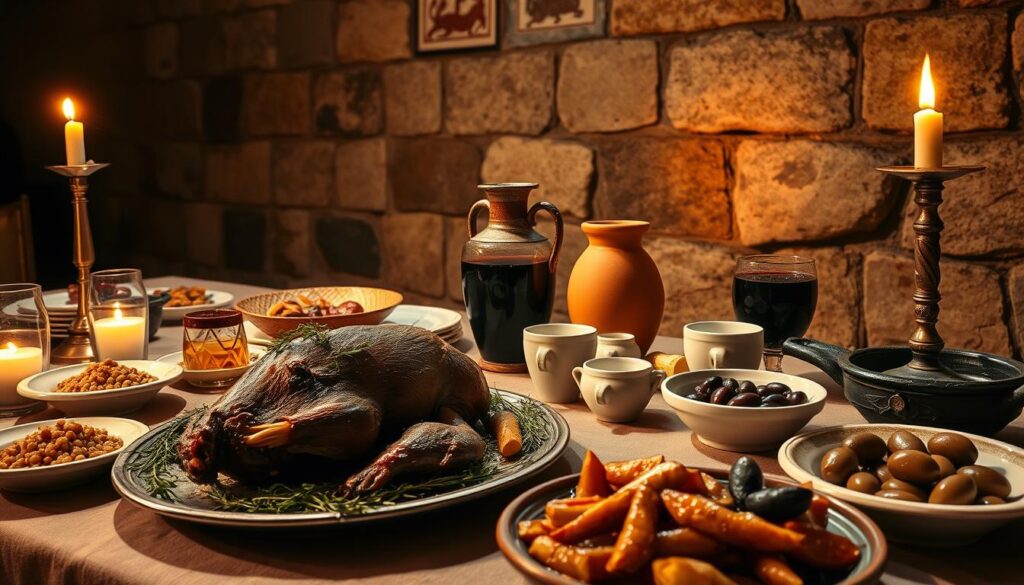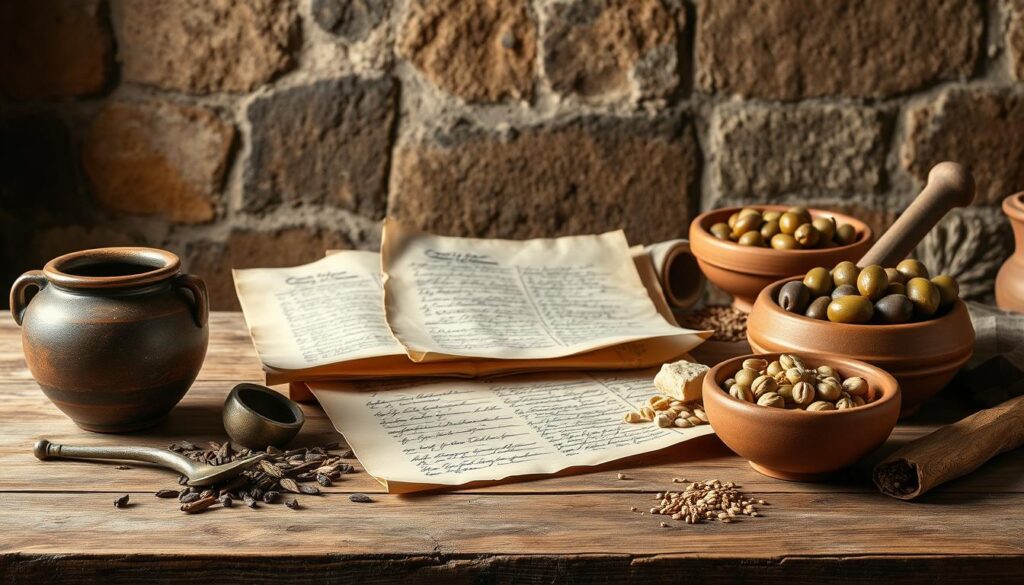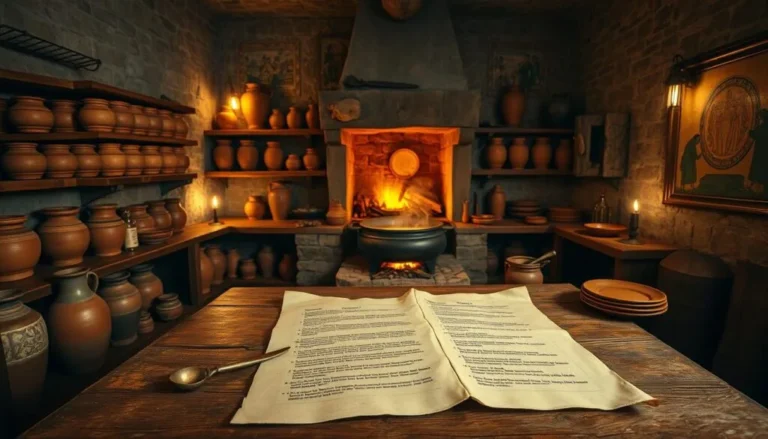Exploring ancient Roman cuisine takes you back centuries. You’ll find recipes that have been loved for generations. These dishes were a big part of daily life, bringing people together with their rich flavors and smells.
This journey will show you the unique ingredients and cooking ways of ancient Rome. Whether you love food, history, or just want to try something new, these recipes are perfect. They use fresh ingredients, simple methods, and bold tastes to make your meals special.
The Introduction to Ancient Roman Cuisine
This section introduces you to ancient Roman cooking. You’ll learn about the ingredients and cooking methods used back then. You’ll also see how Roman cuisine evolved, influenced by the empire’s conquests and cultural exchanges.
Key Takeaways
- You’ll discover the rich history and cultural significance of ancient roman recipes
- Old roman recipes were a staple of everyday life in ancient Rome
- Ancient roman recipes emphasize fresh ingredients, simple techniques, and bold flavors
- You’ll learn about the ingredients, cooking methods, and traditions that made ancient Roman cuisine unique
- Ancient roman recipes are perfect for foodies, history buffs, and anyone looking to spice up their cooking routine
- You’ll get to experience the sights, smells, and tastes of a bygone era through ancient roman recipes
Table of Contents
The History of Ancient Roman Cooking
Ancient Roman cuisine has a rich history, spanning many centuries. As you explore roman recipes, you’ll see how conquest shaped Roman food. The evolution of Roman cuisine was influenced by social class and where they lived.
The ancient Romans loved fine food and drink. They created a unique cuisine from their conquests and trade with other cultures. Ingredients like garlic, onions, and olive oil were common in their diet. The wealthy enjoyed more exotic and expensive ingredients.
- Geographical location: The Romans were in the Mediterranean, giving them access to many ingredients and culinary influences.
- Social class: The Roman social classes greatly influenced the cuisine, with the wealthy enjoying more exotic and expensive ingredients.
- Conquest and trade: The Romans’ conquests and trade with other cultures introduced them to new ingredients and cooking techniques.
Exploring ancient Roman cooking’s history will give you a deeper understanding. You’ll see how conquest and social class shaped Roman recipes and cuisine. This journey through Roman cuisine’s evolution will reveal the impact of these factors.
Essential Ingredients in Ancient Roman Cooking
Exploring ancient Roman cuisine reveals key ingredients in their recipes. Grains like wheat and barley were staples, providing food for many. Onions and garlic were also crucial, adding flavor and texture to dishes.
Meats such as pork and beef were essential, making meals hearty and tasty. These ingredients came from local farms and markets, emphasizing freshness and quality. Their use showed the culture and skill of ancient Roman cooks.
Some of the key ingredients used in ancient Roman cooking include:
- Grains: wheat, barley, and emmer
- Vegetables: onions, garlic, and leafy greens
- Meats: pork, beef, and poultry
Understanding these ingredients helps us appreciate ancient Roman recipes. Whether you want to make traditional dishes or learn about Roman culinary history, exploring these ingredients is a great start.
Traditional Ancient Roman Recipes You Can Make Today
Exploring old roman recipes and ancient roman recipes is a fun journey. It lets you discover the tastes and ingredients of long ago. You can make dishes that were once served at Roman feasts and banquets. These recipes give a peek into ancient Rome’s culinary traditions.
When you explore ancient roman recipes, you’ll see many ingredients and cooking methods are still used today. By using today’s ingredients and cooking ways, you can make these old roman recipes in your kitchen. Whether you’re a pro chef or just curious, these recipes will inspire and please you.
- Mulsum, a honeyed wine that was often served at special occasions
- Libum, a sacred cheese bread that was offered to the gods
- Patina, an ancient roman soufflé that was made with a variety of ingredients, including vegetables and meat
These dishes, and many others like them, show the variety and richness of ancient roman cuisine. By trying these old roman recipes and ancient roman recipes, you can learn more about ancient Rome’s culture and traditions. And you’ll get to enjoy delicious and authentic meals too.
The Role of Garum in Roman Cuisine
Garum was a key condiment in ancient roman cuisine, made from fermented fish sauce. It was crucial for boosting the taste of many roman recipes. You can use Garum to flavor dishes like sauces and marinades.
In ancient roman cuisine, Garum added a salty, umami taste to food. You can create a modern version of Garum by fermenting fish sauce with herbs and spices. This lets you taste the real essence of roman recipes in your kitchen.
Making Garum Substitutes
- Combine fish sauce, herbs, and spices in a jar
- Let it ferment for several weeks to develop the flavor
- Strain and store the Garum substitute in the refrigerator
Using Garum in Contemporary Cooking
Garum is great in many roman recipes, like sauces, soups, and stews. It’s also good as a marinade for meat or veggies. Try different amounts and mixes to get the flavor just right for your dishes.
| Dish | Garum Usage |
|---|---|
| Sauce | 1-2 tablespoons |
| Soup | 1-2 teaspoons |
| Stew | 2-3 tablespoons |
Common Cooking Methods in Ancient Rome
Exploring roman recipes means learning about ancient cooking methods. These methods were simple yet effective. They helped ancient Romans make a variety of tasty meals.
They used roasting, boiling, and frying to cook their food. These techniques helped them make everything from simple veggies to complex meat dishes. You can use these methods to make your own roman recipes, inspired by ancient times.
Some common cooking methods used in ancient Rome include:
- Roasting: This method involved cooking food over an open flame, often using a rotisserie or spit.
- Boiling: This method involved cooking food in liquid, such as water or broth, to create a variety of soups and stews.
- Frying: This method involved cooking food in oil or fat to create crispy and flavorful dishes.
By learning these cooking methods, you can make your own delicious roman recipes. They’re inspired by the flavors and techniques of ancient roman cuisine. Whether you want to try traditional dishes or add ancient roman flair to your meals, these methods will inspire you.
Authentic Roman Feast Dishes
Exploring ancient Roman recipes takes you into the heart of Roman feast dishes. These meals were key to Roman social life, uniting people through food and company. As you try these old recipes, you’ll uncover the rich tastes and ingredients that made Roman food famous.
Start your Roman feast with appetizers, or Gustatio. These dishes were meant to awaken your appetite, often with vegetables, fruits, and nuts. Here are some tasty options:
- Stuffed dates with nuts and honey
- Roasted vegetables with herbs and olive oil
- Fried dough balls served with sweet honey
Next, the main courses, or Primae Mensae, offer a variety of dishes. These include meats, stews, and soups, all made with fresh ingredients. Some main courses to try are:
- Beef stew with vegetables and herbs
- Roasted pork with steamed vegetables
- Grilled fish with olive oil and lemon

No feast is complete without desserts, or Secundae Mensae. These sweet treats often use fruits, nuts, and honey in creative ways. Here are some desserts to enjoy:
- Fruit salad with honey
- Nut cake with sweet cream
- Pastry filled with fruit and nuts
By exploring these Roman feast dishes, you’ll learn more about ancient Roman recipes and their role in Roman culture. Whether you’re looking to recreate these dishes or just want to try new flavors, these recipes are sure to impress and delight.
Ancient Roman Bread Making
Exploring roman recipes, you’ll find bread was key in ancient roman cuisine. Making bread was an art, with many types made from different ingredients. You can make these traditional breads at home with wheat, water, and salt.
In ancient Rome, bread was made from emmer wheat or spelt. These were seen as better than common wheat. The bread-making process involved grinding grains, mixing with water and other ingredients, and baking in a wood-fired oven. You can make your own bread at home with flour, water, and yeast.
Popular breads included panis quadratus, a square bread, and panis focacius, a flatbread with herbs. You can make these at home with traditional roman recipes. Here’s what you need to get started:
- Emmer wheat or spelt flour
- Water
- Salt
- Yeast
- Herbs and other toppings
By using these traditional roman recipes and techniques, you can make delicious breads. These are perfect with your favorite roman dishes. Whether it’s a simple flatbread or panis quadratus, you’ll enjoy the flavors and traditions of ancient Rome at home.
Herbs and Spices in Roman Cooking
In ancient roman cuisine, herbs and spices were key. They added flavor and depth to many dishes. These ingredients were also used for their health benefits. You can bring a taste of ancient Rome into your kitchen by using these herbs and spices.
Common Seasonings
Thyme, rosemary, and garlic were staples in roman cooking. They were used to flavor soups, meats, and more. Try using them to make dishes like a hearty stew or a roasted chicken.
Medicinal Uses in Cuisine
Herbs and spices in ancient Rome were not just for taste. They had health benefits too. For instance, garlic helped with indigestion and skin issues. Discover how these ingredients were used for health and add them to your meals for a nutritious and tasty diet.
Adapting Ancient Roman Recipes for Modern Kitchens
Exploring old roman recipes means looking at the ingredients and tools from ancient times. To make these recipes work in today’s kitchens, some changes are needed. This section offers tips on swapping ingredients and using modern tools to bring ancient Roman flavors to your kitchen.
Modifying Ingredients
To update old roman recipes for today’s kitchens, you might swap some ingredients. For instance, you can mix fish sauce with soy sauce to replace garum. Also, olive oil is a good substitute for lard.

Using Modern Equipment
Modern tools can make cooking ancient roman recipes easier. A slow cooker is great for dishes like patina, a traditional soufflé. A food processor helps with chopping and mixing, speeding up the cooking process.
Here are more tips for adapting ancient roman recipes:
- Choose fresh, seasonal ingredients for the best taste.
- Try different spices and herbs to find the right mix.
- Use traditional cooking methods like stewing and roasting for authentic results.
The Difference Between Poor and Wealthy Roman Diets
In ancient Rome, the diet of the poor and wealthy was very different. The rich had access to exotic and expensive foods. In contrast, the poor ate simpler, more affordable meals. This is seen in the roman recipes we have today, with rich households enjoying complex dishes.
The poor, however, used basic ingredients and cooking techniques. They often ate ancient roman cuisine staples like bread, olives, and vegetables. These were cheap and easy to find. Here’s a table showing some key differences between their diets:
| Diet Type | Food Examples | Cooking Methods |
|---|---|---|
| Poor | Bread, olives, vegetables | Boiling, roasting |
| Wealthy | Exotic meats, expensive spices | Stewing, braising |
The gap between the diets of the poor and wealthy was huge. The rich had a wider variety of foods and cooking styles. This is why roman recipes from that time often include intricate and fancy dishes.
Wine and Other Beverages in Ancient Rome
Exploring ancient roman recipes often shows wine’s big role. In ancient Rome, wine was a common drink for everyone. It’s key to know the wines they made and drank back then.
Types of Roman Wines
Roman wines were famous for their quality and variety. Some top wines were:
- Falernian wine, known for its sweetness and flavor
- Massic wine, a strong and full-bodied wine
- Caecuban wine, a light and refreshing wine
These wines were used in recipes likemulsum, a honeyed wine, andposca, a vinegar drink.
Non-Alcoholic Drinks
Ancient Romans also drank non-alcoholic beverages. They had water, milk, and defrutum, a fruit syrup. These drinks were used in desserts and sauces.
As you look into ancient roman recipes, you’ll see these drinks were important. They added flavor and texture to many dishes.
Conclusion: Bringing Ancient Roman Cuisine to Your Modern Table
The world of ancient Roman cuisine is both fascinating and flavorful. You’ve learned about the evolution of Roman cooking and the key ingredients in their meals. Now, you know how to bring these ancient recipes into your kitchen today.
By embracing the history and flavors of Roman cuisine, you can take your guests back to the Roman Empire. Whether it’s the mulsum, the savory patina, or the versatile garum, the journey is exciting. You can mix old and new by using modern ingredients and cooking tools.
As you delve deeper into ancient Roman recipes, remember the cultural heritage they represent. So, put on your apron, get your ingredients ready, and let ancient Rome’s flavors inspire your cooking. Bon appétit!
FAQ
What are some essential ingredients used in ancient Roman cooking?
Ancient Roman cooking used grains like wheat and barley. They also used vegetables such as onions and garlic. Meats like pork and beef were common too.
What are some traditional ancient Roman recipes I can make today?
You can try making Mulsum (honeyed wine), Libum (sacred cheese bread), and Patina (ancient Roman soufflé). These are traditional Roman recipes.
What was the role of Garum in Roman cuisine?
Garum, a fermented fish sauce, was a key condiment in ancient Rome. It was used to add flavor to many dishes.
What were some common cooking methods used in ancient Rome?
Ancient Romans cooked by roasting, boiling, and frying. They used simple cookware and tools.
What types of appetizers, main courses, and desserts were part of an authentic Roman feast?
An authentic Roman feast included appetizers like Gustatio. Main courses were called Primae Mensae. Desserts were known as Secundae Mensae.
How can I adapt ancient Roman recipes for my modern kitchen?
To adapt ancient Roman recipes, substitute ingredients and use modern tools. Adjust cooking times and methods to get the authentic Roman taste.
What were the differences between poor and wealthy Roman diets?
Poor Romans ate simple, humble foods. Wealthy Romans enjoyed exotic and expensive ingredients.
What role did wine and other beverages play in ancient Roman cuisine and culture?
Wine was a key drink in ancient Rome. They had many types of wine. They also drank non-alcoholic beverages like water and milk.
There are no reviews yet. Be the first one to write one.

